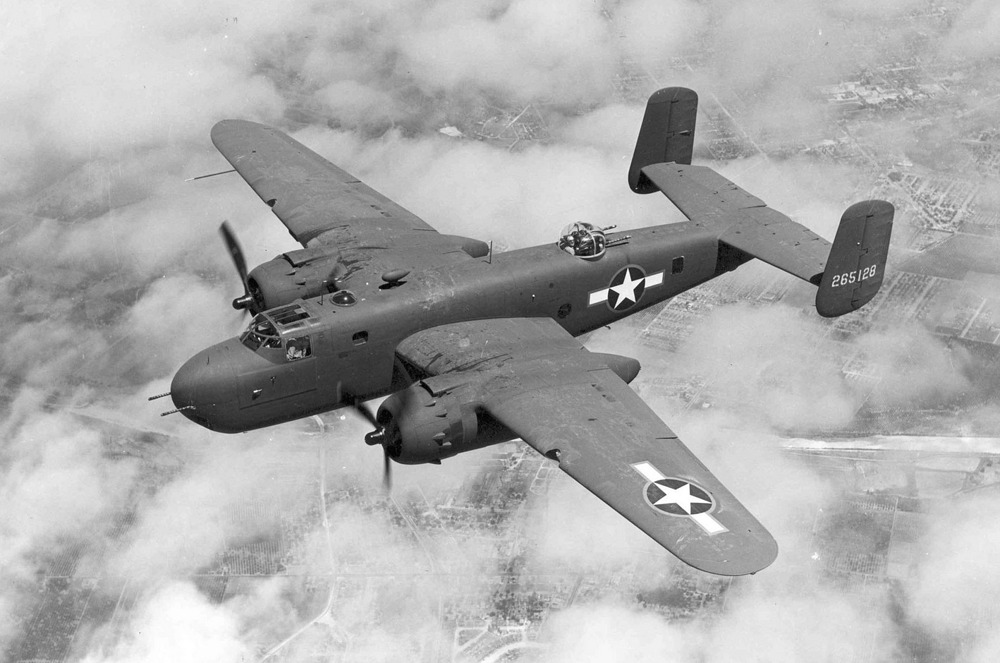History
Combat experience in the Pacific showed that massed bomber formations, while effective in Europe, were unsuited to the widely dispersed and lightly defended targets of the Southwest Pacific. Instead, tactics evolved around skip bombing, parafrag bombs, and strafing attacks. Many B-25C/D aircraft in the region were converted into “strafer” configurations by removing the bombardier’s compartment, deleting the ventral turret, and adding forward-firing armament. Typically, two .50-caliber guns were installed in the nose, while additional gun pods were mounted under the cockpit on each side of the fuselage. These heavily armed Mitchells proved successful in anti-shipping strikes, leading to the development of a factory-produced gunship variant.
This became the B-25G, which mounted a standard 75 mm M4 cannon in a shortened, solid-metal nose. A B-25C-1-NA was modified as the XB-25G prototype and tested between October 1942 and January 1943. Firing trials later proved the cannon could be used repeatedly without damaging the airframe. A recoil cradle extended beneath the pilot’s seat, while a spring-loaded mechanism absorbed the shock of firing. The pilot controlled the gun, while the navigator manually loaded it. The aircraft carried 21 rounds of 75 mm ammunition. The two nose-mounted .50-caliber guns, each with 400 rounds, were retained to assist with aiming. In the cockpit, a type N-3B optical gunsight with a type A-1 combination gun/bomb sight was installed, which could also be used for low-altitude bombing. The added weight reduced top speed to under 280 mph.
North American received a contract to convert 400 new B-25C airframes into the B-25G standard, with production beginning in May 1943 and finishing in August 1943. An additional 63 earlier B-25Cs were field-converted. More than half of the production aircraft were delivered with the retractable ventral turret (serials 42-64802 to 42-65101), but from 42-65102 onward, the turret was deleted in favor of a tail position mounting a single .50-caliber gun.
The first B-25Gs reached Brisbane, Australia, in July 1943 and were committed to combat almost immediately. They used their heavy cannon against shipping, flak positions, and fortifications, particularly during the New Britain campaign, when 1,253 rounds of 75 mm ammunition were fired in just 36 days. Although effective, the cannon had limitations: its slow rate of fire meant only three to four rounds could usually be fired in an attack run, while its low muzzle velocity required straight, close approaches, exposing the aircraft to heavy enemy fire. The navigator’s task of manually loading the gun also restricted the B-25G’s ability to maneuver aggressively after firing.
The B-25G was also deployed in the Mediterranean, but heavy German fighter opposition and dense flak rendered the aircraft unsuited for that theater, and it was quickly withdrawn from front-line service there.
Some B-25Gs received further modifications, including two additional nose guns and four blister-mounted .50-caliber guns on the fuselage sides. Because these packages and other modifications shifted the aircraft’s center of gravity forward, a twin .50-caliber tail turret was installed to help restore balance. By early 1944, during the Marshall Islands campaign, suitable targets for the 75 mm cannon had become scarce. Many B-25Gs had their cannons removed and were converted into heavy strafers, replacing the gun with extra forward-firing .50-caliber weapons in a layout similar to that of later B-25J and PBJ-1J gunships. Most of these modifications were carried out at the Townsville Field Modification Center in Australia.








